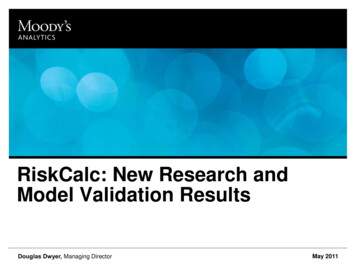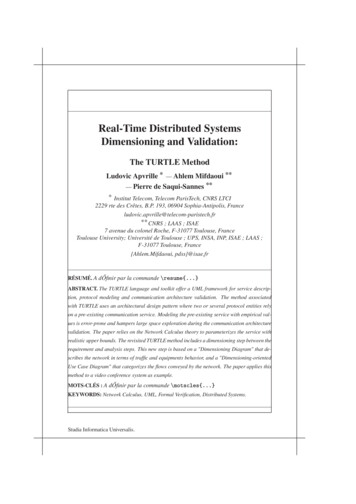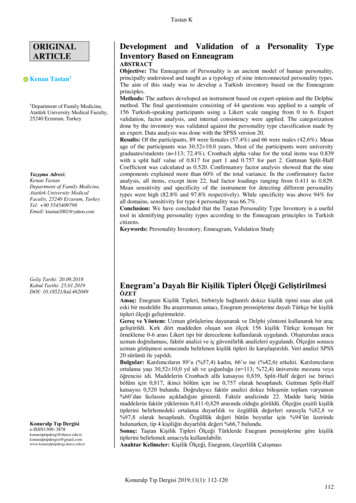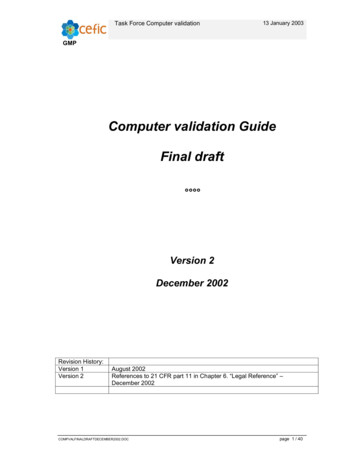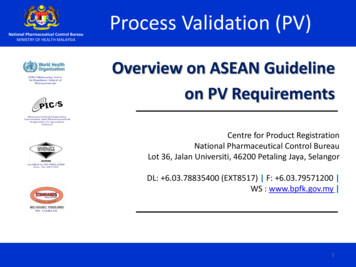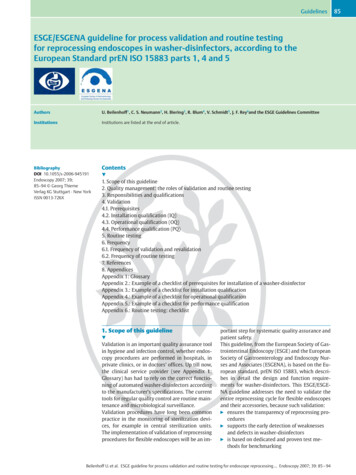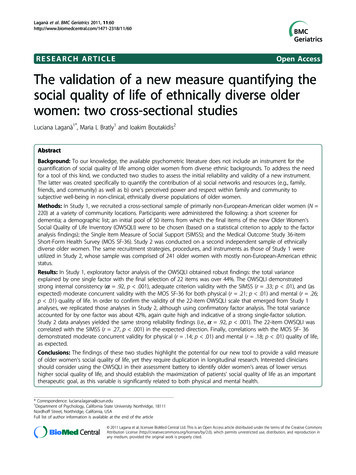
Transcription
Laganà et al. BMC Geriatrics 2011, ESEARCH ARTICLEOpen AccessThe validation of a new measure quantifying thesocial quality of life of ethnically diverse olderwomen: two cross-sectional studiesLuciana Laganà1*, Maria L Bratly1 and Ioakim Boutakidis2AbstractBackground: To our knowledge, the available psychometric literature does not include an instrument for thequantification of social quality of life among older women from diverse ethnic backgrounds. To address the needfor a tool of this kind, we conducted two studies to assess the initial reliability and validity of a new instrument.The latter was created specifically to quantify the contribution of a) social networks and resources (e.g., family,friends, and community) as well as b) one’s perceived power and respect within family and community tosubjective well-being in non-clinical, ethnically diverse populations of older women.Methods: In Study 1, we recruited a cross-sectional sample of primarily non-European-American older women (N 220) at a variety of community locations. Participants were administered the following: a short screener fordementia; a demographic list; an initial pool of 50 items from which the final items of the new Older Women’sSocial Quality of Life Inventory (OWSQLI) were to be chosen (based on a statistical criterion to apply to the factoranalysis findings); the Single Item Measure of Social Support (SIMSS); and the Medical Outcome Study 36-itemShort-Form Health Survey (MOS SF-36). Study 2 was conducted on a second independent sample of ethnicallydiverse older women. The same recruitment strategies, procedures, and instruments as those of Study 1 wereutilized in Study 2, whose sample was comprised of 241 older women with mostly non-European-American ethnicstatus.Results: In Study 1, exploratory factor analysis of the OWSQLI obtained robust findings: the total varianceexplained by one single factor with the final selection of 22 items was over 44%. The OWSQLI demonstratedstrong internal consistency (a .92, p .001), adequate criterion validity with the SIMSS (r .33; p .01), and (asexpected) moderate concurrent validity with the MOS SF-36 for both physical (r .21; p .01) and mental (r .26;p .01) quality of life. In order to confirm the validity of the 22-item OWSQLI scale that emerged from Study 1analyses, we replicated those analyses in Study 2, although using confirmatory factor analysis. The total varianceaccounted for by one factor was about 42%, again quite high and indicative of a strong single-factor solution.Study 2 data analyses yielded the same strong reliability findings (i.e., a .92, p .001). The 22-item OWSQLI wascorrelated with the SIMSS (r .27, p .001) in the expected direction. Finally, correlations with the MOS SF- 36demonstrated moderate concurrent validity for physical (r .14; p .01) and mental (r .18; p .01) quality of life,as expected.Conclusions: The findings of these two studies highlight the potential for our new tool to provide a valid measureof older women’s social quality of life, yet they require duplication in longitudinal research. Interested cliniciansshould consider using the OWSQLI in their assessment battery to identify older women’s areas of lower versushigher social quality of life, and should establish the maximization of patients’ social quality of life as an importanttherapeutic goal, as this variable is significantly related to both physical and mental health.* Correspondence: luciana.lagana@csun.edu1Department of Psychology, California State University Northridge, 18111Nordhoff Street, Northridge, California, USAFull list of author information is available at the end of the article 2011 Lagana et al; licensee BioMed Central Ltd. This is an Open Access article distributed under the terms of the Creative CommonsAttribution License (http://creativecommons.org/licenses/by/2.0), which permits unrestricted use, distribution, and reproduction inany medium, provided the original work is properly cited.
Laganà et al. BMC Geriatrics 2011, ackgroundThe growing diversity of aging populations and corresponding expectations of successful aging have motivated multidisciplinary investigations of quality of life(abbreviated as QofL herein). Several researchers havehighlighted the need to develop assessment tools toproperly quantify psychosocial variance in older age[1-4]. Research on social facets of QofL in later life maycontribute to an increased understanding of protectivesocial resources that could enhance the biopsychosocialhealth of older adults. In turn, this process could assistin addressing the aging population’s health care impacton public resources, leading to a more cost-effective useof the health care system [5-7]. The social QofL of olderwomen in particular should be a topic of focused investigation because this population, compared to oldermen, typically seeks medical help more often, experiences less than adequate assistance with basic life activities, and reports fewer financial resources [8-10].Considering the aforementioned disadvantages, maximizing older women’s social QofL (assessed using amethodologically appropriate measure) is critical.The focus of the present research is the initial validation of a new social QofL tool, which is intended for usewith older women from diverse ethnic backgrounds.Ethnic minorities in general are understudied in QofLresearch for a variety of reasons. Several researchershave identified factors such as low socioeconomic status[11,12] (a characteristic of many ethnically diverse olderwomen [10]) and limited English-language proficiency[13] as barriers to the inclusion of ethnic minoritygroups in QofL studies. Also, scarcity of culturally-competent (preferably same-culture) researchers is oftenproblematic [14]. In addition, older women’s limitedfinancial means can present difficulties regarding transportation to research sites [15]. We have minimizedthese challenging issues in the current research, asdescribed in the Methods section. There is ample evidence on the contribution of social variables (such asthe need to feel loved [16,17] as well as respected andvalued by others [18,19]) to the well-being of olderwomen (and men). Many such issues hold unique relevance among older individuals from ethnic minoritybackgrounds due to the emphasis placed upon family,friends, and the community at large, as they typicallyfavor a collectivistic orientation [20].In research on older women, a satisfying social life hasbeen related to better physical health. For instance, in astudy on 471 women over the age of 60 living with cardiac disease, respondents in recovery from cardiacevents who had satisfactory social resources displayedfewer depressive symptoms and better coping skills [21].Moreover, those who reported greater social supportPage 2 of 13exhibited enhanced emotional well-being, lower symptom impact, and greater perceived health. Social networks could produce satisfying and trustingrelationships with family and close friends and, importantly, enhance older women’s ability to compensate forphysical functioning deficits by reducing levels of distress [23]. Indeed, mental health is significantly relatedto satisfaction with one’s social life and resources.Numerous studies have confirmed the positive role ofsocial support, integration, and engagement in providingpsychosocial benefits for improved mental well-beingand QofL in later life [5,24-26]. Additionally, Jang,Haley, Small, and Mortimer [22], in a study of 406women (60 years old and older) diagnosed with cardiacdisease, discovered that social resources enhanced psychological resilience. Social integration may also protectolder adults from cognitive decline by positively influencing social competence and mood [27]. Furthermore,emotional and social expectations attached to socialinteractions afford a perception of continued value,meaningful connections to others, and emotional support for reassurance and affection, which contribute tomorale and satisfaction in older age [28,29]. In addition,social resources are associated with enhanced feelings ofself-esteem, which may strengthen older adults’ copingskills and lessen the impact of negative life events,losses, and functional decline [22,30].The Need for a Measure of Older Women’s Social QofLDue to the lack of an appropriate measure to quantifysocial QofL in older women, to date, researchers interested in assessing psychosocial aspects of well-being inthis population have relied mostly on health-relatedQofL measures that were typically not designed to capture the increasing diversity of older populations.Furthermore, by definition, all health-related QofLinstruments confound physical health status with socialwell-being, if they assess the latter at all. Given theadvanced age of our target population and the corresponding high potential for health problems and functional limitations that could extend to all areas of olderwomen’s lives, instruments need to be developed for thequantification of social QofL independently from physical/medical symptomatology. This task should beaccomplished with a measure that is designed to be sensitive to culturally-relevant social variables, given theethnic diversity of older women populations. However,few researchers have targeted the above-mentionedQofL issues within non-clinical older populations fromdiverse ethnic backgrounds [31]. In fact, a web-basedsearch for this kind of tool resulted in few qualifiedmeasures. What follows is a brief review of some of thepopular QofL scales, organized by their limitations in
Laganà et al. BMC Geriatrics 2011, ssessing social QofL in the target population of thepresent research.Researchers Must Be Able to Discriminate BetweenPhysical and Social QofLMost of the commonly used measures confound socioemotional QofL with physical/medical health. For example, the utilization of the Medical Outcome Study 36Item Short-Form Health Survey (MOS SF-36) [32] allowsthe quantification of both physical and mental healthcomponents of QofL. While researchers who implemented this measure have reported good sensitivity as wellas cross-cultural generalizability [33-35], the MOS SF-36was constructed mainly to quantify limitations in social(and other) activities caused by health problems, thusconfounding general health status and functional losswith QofL. Similarly, the Quality of Life Index - GenericVersion (QLI) [36] and the World Health Organization’sQofL assessment (WHOQofL-100) [37] confound socialaspects of QofL (such as social and family functioning)with health status.Assessment Tools Must Allow Generalization of Findingsto Non-Clinical PopulationsMeasures designed specifically for use with clinicalpopulations (including individuals with acute mental disorders or medical diagnoses) may not be sensitive tominor changes in status within non-clinical populations.To offer an example, one of the earliest QofL assessments, the Spitzer QL-Index [38] has been shown toeffectively assess general health, social support, and psychological outlook. However, this assessment tool wasvalidated on cancer patients in palliative care. A scaledesigned to be relevant to individuals with terminal illness may not be sufficiently discriminatory or applicableto healthy–or relatively healthy–populations. Similarly,the 46-item Schedule for the Evaluation of IndividualQuality of Life (SEIQoL) [39] and the SEIQoL-DW15item version [40] were originally created to assess QofLin palliative care settings. Although empirical evidenceseems to indicate that both measures are psychometrically sound, the appropriateness of their application forroutine use in non-palliative care settings or with individuals without serious illness is dubious [41]. Similar criticism can be applied to the Nottingham Health Profile(NHP) [42] and the Quality of Well-Being Scale (QWS)[43,44], which primarily assess the impact of disease andillness, making their applicability to fairly healthy populations questionable.Measures Need to Be Validated on Ethnically DiverseOlder Adult PopulationsFew QofL measures have been explicitly normalized orpsychometrically validated on ethnically diversePage 3 of 13populations, which limits their external validity. Indeed,researchers have challenged assumptions of the universality of health-related assessment tools such as the MOSSF-36 [45]. In particular, Staniszewska, Ahmed, and Jenkinson discovered that cultural influences in White andIndian cardiac patients’ descriptions of their physicalhealth were similar, yet greater avoidance of terms suchas “mental” and “emotional” surfaced among Indian participants. Additionally, different religious perceptionsaffected the interpretation of disease by these twogroups. Deyo conducted a study [46] comparing the original English language version of the Sickness ImpactProfile (SIP) [47] (a well-established self-report measureof physical QofL/functional health status) to a Spanishlanguage version within a sample of non-Hispanic andMexican-American participants with low back pain. TheSIP produced results with English-speaking individualsthat seemed highly valid, while findings for MexicanAmerican participants who used the English languageSIP measure were poor. Mexican-American patientsusing the Spanish version of the SIP obtained the poorest results. This suggests that simply producing an adequate translation of the SIP does not address culturallyunique responses to symptoms, such as the reluctanceof some cultures to answer personal questions and thegeneral effects that acculturation may produce in thecomfort level experienced by individuals responding toscale items [45].Many popular QofL measures appear to disregardolder adults, a segment of the population for whom reliable assessment of the social components of QofL maybe especially critic
RESEARCH ARTICLE Open Access The validation of a new measure quantifying the social quality of life of ethnically diverse older women: two cross-sectional studies

